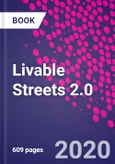Livable Streets 2.0 offers a thorough examination of the struggle between automobiles, residents, pedestrians and other users of streets, along with evidence-based, practical strategies for redesigning city street networks that support urban livability. In 1981, when Donald Appleyard's Livable Streets was published, it was globally recognized as a groundbreaking work, one of the most influential urban design books of its time. Unfortunately, he was killed a year later by a speeding drunk driver. This latest update, Livable Streets 2.0, revisited by his son Bruce, updates on the topic with the latest research, new case studies and best practices for creating more livable streets.
It is essential reading for those who influence future directions in city and transportation planning.
- Incorporates the most current empirical research on urban transportation and land use practices that support the need for more livable communities
- Includes recent case studies from around the world on successful projects, campaigns, programs, and other efforts
- Contains new coverage of vulnerable populations
Please Note: This is an On Demand product, delivery may take up to 11 working days after payment has been received.
Table of Contents
Part IStreet Conflict: Living With Traffic
1. Three Streets in San Francisco
Donald & Bruce Appleyard
2. The Ecology of the Street
Donald & Bruce Appleyard
3. Street Images, Values, and Problems
Donald & Bruce Appleyard
4. Intrusion, Disruption, and Problems
Donald & Bruce Appleyard
5. Traffic, Streets, Improvements, and Income Levels -- A Summary
Donald & Bruce Appleyard
6. The Vulnerable Groups
Donald & Bruce Appleyard
7. The Meaning of Livable and Complete Streets to Schoolchildren
Bruce Appleyard
8. The Human Scale Relationships of Traffic, Street Livability, Health, & Equity: A Review of Determinants and Barriers to Physical, Mental, and Social Health
Bruce Appleyard,
9. Cars, conflict and community severance
Laura Vaughan, Paulo R. Anciaes, Jennifer S. Mindell
Part II
Street Power And Politics
10. Introduction to History
Bruce & Donald Appleyard
11. Original, Pre 1980 History
Bruce & Donald Appleyard
12. Contemporary History
Bruce Appleyard
13. Early Street Battles of Britain
Donald & Bruce Appleyard
14. Early Street Battles of the SF Bay Area
Donald & Bruce Appleyard
15. Street Fights for Livability, Health, and Humanity: Power and Politics
Donald & Bruce Appleyard
16. The Power and Politics of the Street
Bruce & Donald Appleyard
Part III -The Promise Of Our Streets: Principles, Processes, Prescriptions And The "Art" Of Street Re-Envisioning And Redesign
17. Toward an Ethical Livability for Street Empathy, Equity & Justice
Bruce Appleyard
18. A Charter for Humane & Equitable Streets: A Statement of Principles, Strategies, Goals, Objectives, and Tactics to Realize the Promise of the Ideal Street
Bruce & Donald Appleyard with David Lenson and William Riggs
19. PROCESSES AND PRINCIPLES FOR CREATING LIVABLE & COMPLETE STREETS AND COMMUNITIES
Bruce Appleyard
20. Tools, Rules, and Techniques
Bruce Appleyard
21. Realizing the promise of our streets: The Generation, Articulation and Communication of Alternatives
Bruce Appleyard
Part IV: The Challenge And Future For Of Our Streets
22. Streets Can Kill Cities: Third World Beware
Donald & Bruce Appleyard
Authors
Appleyard, Bruce Bruce Appleyard, PhD is an Associate Professor of City Planning and Urban Design at San Diego State University (SDSU) and the Assistant Director of Active Transportation Research (ATR) where he helps people make more informed decisions about how we live, work, play, and thrive. He specializes in pedestrian and bicycle planning and design and is an expert at working with people so they can celebrate the humanity of their streets and communities together.Dr. Appleyard has authored dozens of publications including the nationally lauded Handbook for Building Livable Transit Corridors (National Academies Press, 2016) and The Transportation/Land Use Connection (American Planning Association, 2007).In 2006, the Robert Wood Johnson Foundation named Bruce as one of their Top Ten "Active Living Heroes for his work helping communities, alongside other notable figures including Barack Obama. He is passionate about helping people create joyful and enriching communities that reflect their spirit and identity, are economically vibrant, and yield environmental and health benefits for all.
Dr. Appleyard holds a Doctorate (as well as a Masters and Bachelors) from the University of California, Berkeley.
Affiliations and Expertise








